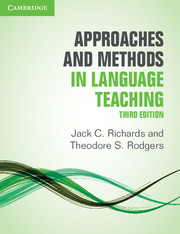Book contents
- Frontmatter
- Contents
- Acknowledgments
- Introduction to the third edition
- I Major trends in twentieth-century language teaching
- II Current approaches and methods
- III Alternative twentieth-century approaches and methods
- IV The teaching and learning environment
- Appendix: Comparison of approaches and methods
- Author index
- Subject index
IV - The teaching and learning environment
Published online by Cambridge University Press: 08 April 2022
- Frontmatter
- Contents
- Acknowledgments
- Introduction to the third edition
- I Major trends in twentieth-century language teaching
- II Current approaches and methods
- III Alternative twentieth-century approaches and methods
- IV The teaching and learning environment
- Appendix: Comparison of approaches and methods
- Author index
- Subject index
Summary
The chapters in Part IV focus on the contributions of the learner and the teacher to learning and teaching processes as well as the status of approaches and methods in the curriculum development process. Chapter 19 examines the roles of the learner and how these roles intersect with approaches and methods. In this chapter, we look at learner autonomy, learner strategies, learning styles, and the role of technology. Part of the message of this chapter is that learning is not the mirror image of teaching. The learner-autonomy movement as well as research on learning strategies and learning styles emphasize that learners can be actively involved in managing and directing their own learning and that one of the goals of teaching is to enable learners to take more responsibility for their own learning. Technology can play an important role in facilitating self-directed learning on the part of learners, allowing them to personalize their learning further; it can also increase motivation.
Chapter 20 looks at the role of the teacher and issues that teachers confront in relation to how they approach their teaching. One strategy is for teachers to adopt the prescriptions of an approach or method and to try to match their teaching style to that of the method. This involves changes in beliefs as well as practice. A second approach is to adapt the method to the teacher's local needs and context, perhaps drawing on principles and procedures from different methods. A third strategy is for the teacher to develop his or her own teaching approach based on beliefs, experience, and the theorization of practice. Implications of each of these positions for both teaching and teacher training are explored in this chapter.
Chapter 21 then considers approaches and methods from the perspective of curricu-lum development. Traditionally, syllabus design was a forward development process, where the language, or input, was first determined, and the teaching process and output, or goals, followed. Alternatively, the teaching process itself may be the starting point in curriculum planning and the syllabus an outcome of teaching, which is referred to here as central design.
- Type
- Chapter
- Information
- Approaches and Methods in Language Teaching , pp. 329 - 330Publisher: Cambridge University PressPrint publication year: 2014

